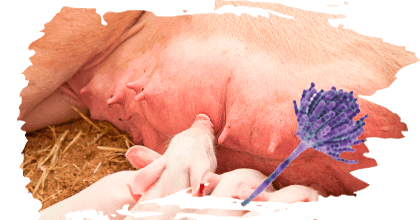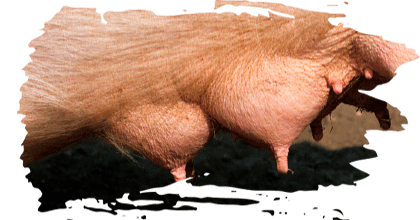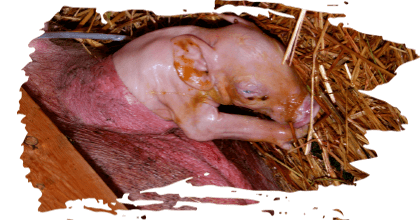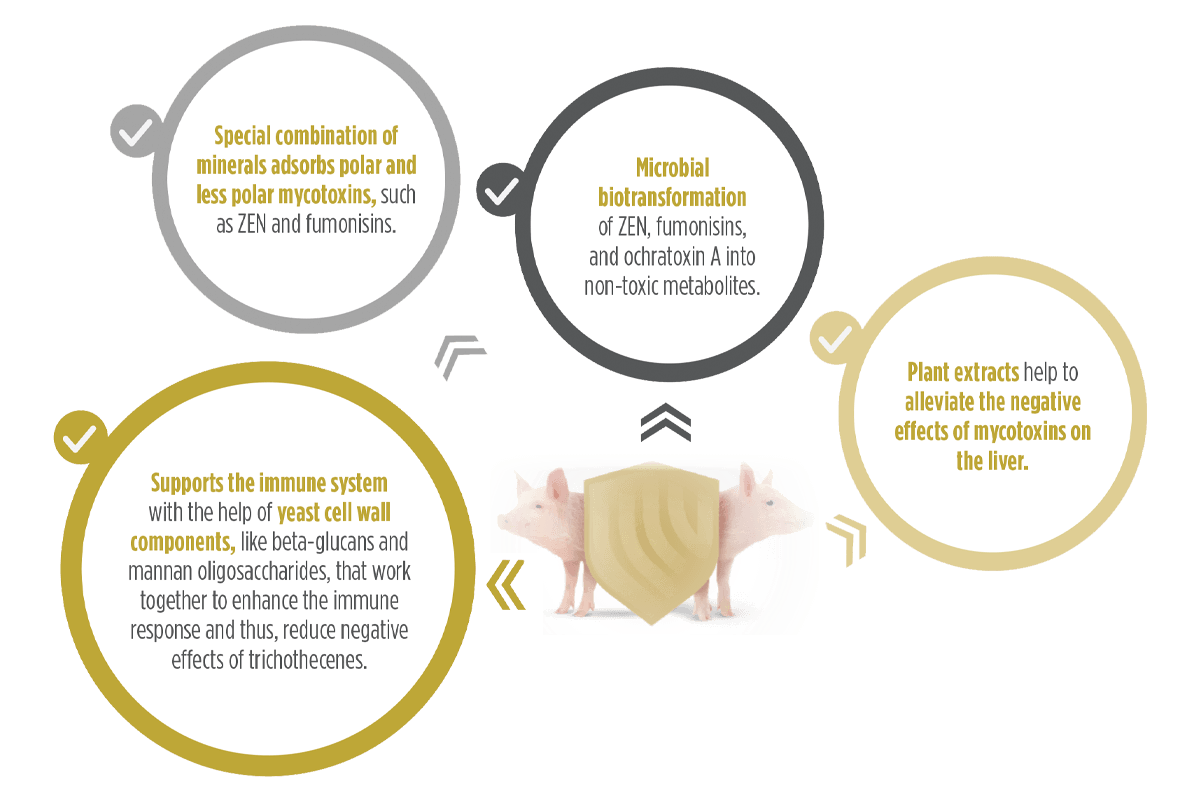MYCOTOXINS: A CONSTANT THREAT
Mycotoxins are toxic compounds produced by certain types of molds found in grain and feedstuffs.
Specifically, mycotoxins such as aflatoxin, deoxynivalenol (vomitoxin), fumonisins, ochratoxin A, T-2 toxin, and zearalenone have been identified as harmful to swine health.
The presence of these well-known and regulated mycotoxins in feed can lead to a range of adverse effects, including:
 Reduced feed intake
Reduced feed intake Impaired growth
Impaired growth
 Liver damage
Liver damage Gastrointestinal dysfunction
Gastrointestinal dysfunction Oxidative stress
Oxidative stress Various reproductive issues
Various reproductive issues
 Mycotoxins can have a significant impact on the health and reproductive performance of sows. The impact of mycotoxins on sow fertility and reproductive performance is well-documented, with several studies highlighting the various negative outcomes associated with mycotoxin exposure.
Mycotoxins can have a significant impact on the health and reproductive performance of sows. The impact of mycotoxins on sow fertility and reproductive performance is well-documented, with several studies highlighting the various negative outcomes associated with mycotoxin exposure.Mycotoxins can cause direct effects on reproductive performance, such as:
 Irregular heats
Irregular heats Abortion
Abortion Pseudopregnancy
Pseudopregnancy Low conception rates
Low conception rates
 Ovarian cysts
Ovarian cysts Embryonic loss
Embryonic loss Nymphomania
Nymphomania Hypertrophy of the uterus
Hypertrophy of the uterus Hyperestrogenism
Hyperestrogenism Agalactia
Agalactia Stillbirths
Stillbirths Infertility
Infertility
![]() Diagnosis can be challenging due to vague symptoms and the presence of mycotoxins below detection limits.
Diagnosis can be challenging due to vague symptoms and the presence of mycotoxins below detection limits.
To make things worse, emerging mycotoxins are even less often analyzed, as they require sophisticated analytical devices for detection, and regulatory limits are missing.
![]() However, some of the emerging mycotoxins are known to negatively affect swine.
However, some of the emerging mycotoxins are known to negatively affect swine.


MYCOTOXINS AND REPRODUCTION
Zearalenone
One of the most studied mycotoxins in relation to swine reproduction is zearalenone (ZEN), produced by Fusarium species and commonly found in cereals such as corn, wheat, oats, and barley.
ZEN is known to mimic estrogenic activity and can lead to a range of reproductive disorders.
For example, ZEN exposure has been associated with:
 Vulvar swelling
Vulvar swelling
 Disturbances in reproductive hormones
Disturbances in reproductive hormones
 Alterations in estrogen receptor concentrations in specific organs of sows
Alterations in estrogen receptor concentrations in specific organs of sows
In sows, exposure to ZEN can lead to symptoms such as swelling of the vulva, abnormal estrous cycles, ovarian atrophy, and reduced fertility. For instance:
Young, immature gilts exposed to 1–5 ppm of ZEN may show swelling of the vulva and some estrus activity, while pubertal gilts and sows during the breeding period exposed to 5–10 ppm may experience increased postweaning intervals and extended intervals between cycles.
Gestating sows exposed to >25 ppm of ZEN can have small litters, low farrowing rates, and pseudopregnancy, and lactating sows exposed to >50 ppm may exhibit abnormal estrous cycles and ovarian atrophy.

 The economic implications of ZEN contamination are significant for swine production operations.
The economic implications of ZEN contamination are significant for swine production operations.
⇰ Reproductive performance is fundamental to the economic success of these operations, and problems such as those caused by ZEN can lead to reduced numbers of piglets, which in turn leads to financial losses.
The exact profit calculation related to the impact of ZEN on sows can vary widely depending on the extent of the contamination, the pork prices, and the farm’s specific management practices.
However, it is clear that both determining the cause of a decline in reproductive performance and implementing corrective measures can incur high costs.
Scientific publications have provided guidance levels to mitigate the risks of ZEN. For example, the European Commission has defined recommended thresholds for complementary and complete feeding stuffs, reflecting the differences in susceptibility among age groups.
![]() These guidance levels are set at 100 ppb for gilts and piglets and 250 ppb for sows and fatteners.
These guidance levels are set at 100 ppb for gilts and piglets and 250 ppb for sows and fatteners.

Trichothecenes
Trichothecenes, which include DON and T-2 toxin, are also of concern, as they can cause direct toxic effects on the reproductive tract, leading to conditions such as:
 Ovarian dysfunction
Ovarian dysfunction Reduced conception rates
Reduced conception rates Increased incidence of stillbirths
Increased incidence of stillbirths
The presence of these mycotoxins in feed has been linked to irregular heats, pseudopregnancy, and reduced fertility in sows.

Fumonisins
Fumonisins, another class of mycotoxins, have been implicated in causing alterations in sphingolipid metabolism, which is crucial for cell membrane integrity and function.
⇰ This disruption can have implications for oocyte quality and embryonic development, potentially leading to reduced fertility and increased prenatal loss in sows.
PREVENTION IS THE ONLY SOLUTION
After molds produce mycotoxins on the crops in the field or storage, mycotoxins cannot be removed anymore from the animal feed.
 This means that the only solution for preventing mycotoxicosis is using feed additives to adsorb or detoxify mycotoxins.
This means that the only solution for preventing mycotoxicosis is using feed additives to adsorb or detoxify mycotoxins.

CONCLUSIONS ![]()
Mycotoxins pose a significant threat to sow fertility and health.
![]() Understanding their effects is essential for effective swine herd management and ensuring the profitability and sustainability of swine production operations.
Understanding their effects is essential for effective swine herd management and ensuring the profitability and sustainability of swine production operations.
Given the significant impact of mycotoxins on sow fertility and health, it is essential for swine producers to implement effective mycotoxin management strategies. These may include:
 Ensuring proper storage and handling of feed ingredients to minimize fungal growth and mycotoxin production.
Ensuring proper storage and handling of feed ingredients to minimize fungal growth and mycotoxin production. Regular monitoring of feed for mycotoxin contamination.
Regular monitoring of feed for mycotoxin contamination. Use of advanced mycotoxin deactivating feed additives.
Use of advanced mycotoxin deactivating feed additives.
 MYCORAID helps to ensure high production levels and profitability on the farm!
MYCORAID helps to ensure high production levels and profitability on the farm!





 Micotoxicosis prevention
Micotoxicosis prevention